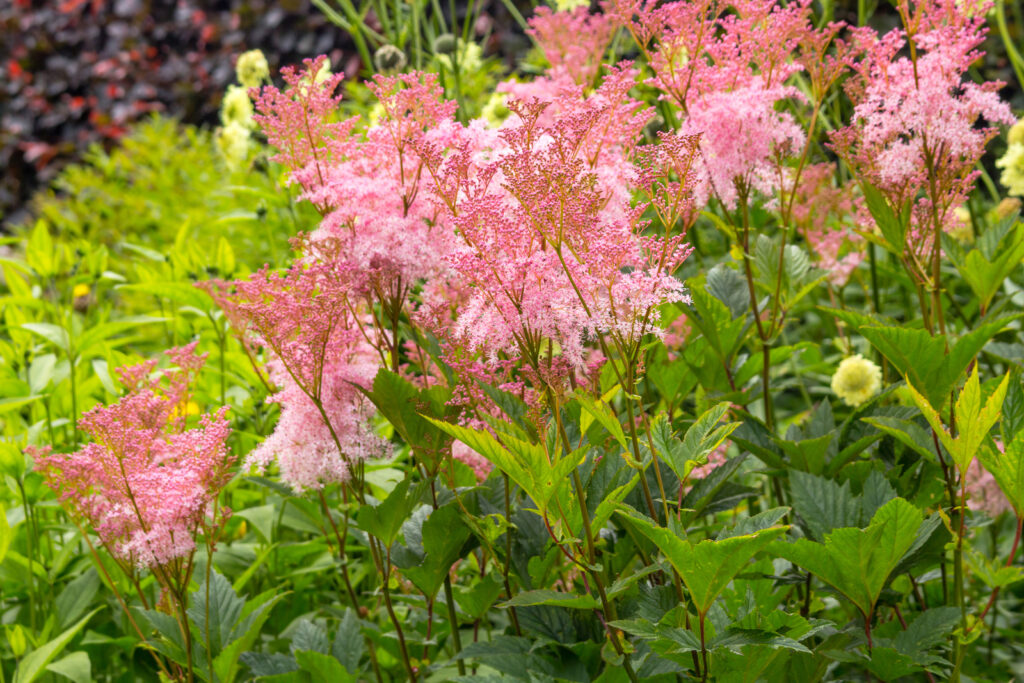Filipendula–commonly call queen-of-the-prairie–is an upright moisture-loving perennial with deeply cut green leaves. From early to midsummer, it produces heads of fluffy pink flowers on tall slender stems. Filipendula is a favorite of bees.
Plant Filipendula in full sun in cool-summer regions; plant it partial shade in hot summer regions. Filipendula grows best in soil that stays evenly moist.
Filipendula goes dormant in winter, even in mild regions. There are 10 species in the Filipendula genus all are rhizomatous perennials native to damp habitats.

Get to know Filipendula
- Plant type: Perennial
- Growing Zones and range: Zones 3 to 8
- Hardiness: Hardy to -10°F (-23°C)
- Height and width: 6 to 8 feet (1.8-2.4m) tall; 3 to 4 (1-1.2m) wide
- Foliage: Coarsely divided leaves that look like fern fronds; large leaves provide dramatic texture when the plant is not in bloom
- Flowers: Plumes of tiny, fluffy, red, pink, or white flowers are borne from late spring to late summer;
- Bloom time: Tall stems with fluffy pink panicles
- Uses: Place at the rear of the flower border; a good choice for low, wet soil as well as drier sites; use at the edge of ponds and streams
- Common name: Queen-of-the-Prairie, meadowsweet
- Botanical name: Filipendula species
- Family: Rosaceae
- Origin: Northern temperate regions
Where to plant Filipendula
- Grow Filipendula in full sun.
- Filipendula grows well in wet or boggy soil. Keep the soil moist to wet.
- Filipendula grows best in slightly acidic soil (pH 5.5-7.0).
Filipendula uses and companions
- Use Filipendula as a back-of-border plant for large-scale gardens.
- Naturalize Filipenula in a moist meadow or along a stream.
- Good garden companions for Filipendula include Astilbe, Hosta, Lobelia cardinalis, and Lythrum.

When to plant Filipendula
- Set Filipendula plants in the garden in spring.
- Sow seed in autumn in containers in a cold frame.
- Take root cutting from late winter to early spring.
Planting and spacing Filipendula
- Space Filipendula 5 to 8 feet (1.5-2.4m) apart.
- Sow seed in evenly prepared soil.
How to water and Filipendula
- Keep the soil moist.
- Fertilize Filipendula every 4 to 6 weeks or work in a slow-release fertilizer in spring. Stop fertilizing 4 to 6 weeks before the first frost.
Filipendula care
- Mulch around Filipendula to keep the soil from drying out.
- Remove spent blooms.
- Divide roots in spring as needed.
- Spider mites and mildew can be a problem if the soil becomes dry and the plant is not adequately watered.
Filipendula pests and diseases
- Powdery mildew, rust, and leaf spot can occur.
Filipendula propagation
- Sow seed in autumn in containers in a cold frame.
- Filipendula seeds will germinate in about 21 days at 68°-77°F (20°-25°C).
- Divide plants in autumn or spring.
- Take root cutting and place them horizontally in seed trays from late winter to early spring.
Filipendula varieties to grow
- Filipendula purpurea: Grows 3 to 4 feet tall with maplelike leaves; bears tall plumes; ‘Alba’ is white. ‘Elegans’ is white with red stamens, ‘Nana’ is salmon pink.
- F. rubra, queen of the prairie: grows to 8 feet tall and bears pink plumes; cultivar ‘Venusta’ has deep pink flowers.
- F. ulmaria, queen-of-the-meadow is a short cultivar 24 to 36 inches tall and has creamy white flowers; it prefers afternoon shade; the cultivar ‘Aurea’ has yellow leaves in spring; they become lighter in summer.
- F. vulgaris, dropwort: grows to 3 feet tall with white plumes.















